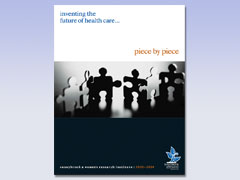Deconstructing T Cell Development
Take a Petri dish. Put stem cells in it. Add some delta-like molecules and stromal cells. Mix well. Let stand for a while. Congratulations. You have just made T cells.
Okay–so it's not this simple–not even almost; but, remarkably, there now is a way to create T cells from stem cells this way, thanks to SWRIsenior scientist Dr. Juan Carlos Zúñiga-Pflücker and his then-graduate student, Thomas Schmitt. In 2002, they did what previously was undoable.
Zúñiga-Pflücker laughs as he recalls the process. "It's almost like an equation. You have these three variables, and if you put them together, it's a combination that gives you a T cell as opposed to something else. And that is likely to be useful one day."
Indeed, the breakthrough has huge implications – if scientists can create immune-essential T cells at will, then doctors can treat immune-wrecking diseases, like AIDS and cancer.
We need T cells. Without them, our immune systems would collapse. In the body, stem cells with the potential to be various kinds of cells travel from the bone marrow to the thymus. There, some become T cells. Unlike B cells and other immune cells, which grow in bone marrow, T cells develop only in the thymus. This posed a challenge for scientists.
"Puzzling us for years was what is it about the thymus that is unique and special, that isn't in the bone marrow, which allows T cells to grow there as opposed to elsewhere?" says Zúñiga-Pflücker.
This was a driving question, because the molecule that controlled signalling was unknown. Also, researchers had grown T cells only in thymus-like structures. They thought three-dimensionality was critical. "That was the dogma – people thought that T cell development was unique because it required a complex structure to take place in," he says.
So he and Schmitt started their experiments. In culture (i.e., a Petri dish), they combined stem cells from the bone marrow, delta-like molecules from the thymus and bone-marrow-supporting stromal cells. This combination, and importantly the delta-like molecule, turned out to be the solution.
"We never actually assumed this would support T cell development from beginning to end, because we belonged to that group that thought, 'Oh, it's complicated; you need a whole structure,'" says Zúñiga-Pflücker. They were delightfully surprised.
"The nice result was that the T cell not only began to look like a T cell, it basically ended up being a mature, functional – as if it was in the thymus – type of T cell."
This allows scientists to study T cell development in a straightforward system, so they can advance the work toward clinical translation, still years away. Today, Zúñiga-Pflücker's lab is tackling challenges like creating stem cells from different sources and making a "plastic thymus."
Science – the process of – is like a story on a loop: it has a beginning, middle and end, and then another beginning. Zúñiga-Pflücker's start came as an undergraduate student, when he fell in love with the idea of T cell development. Since then, it's been a series of middles and ends and new beginnings. Lucky for the field of T cell development. Very lucky.
The Canadian Institutes of Health Research and the National Cancer Institute of Canada funded Zúñiga-Pflücker's research in this area.
PDF / View full media release »





